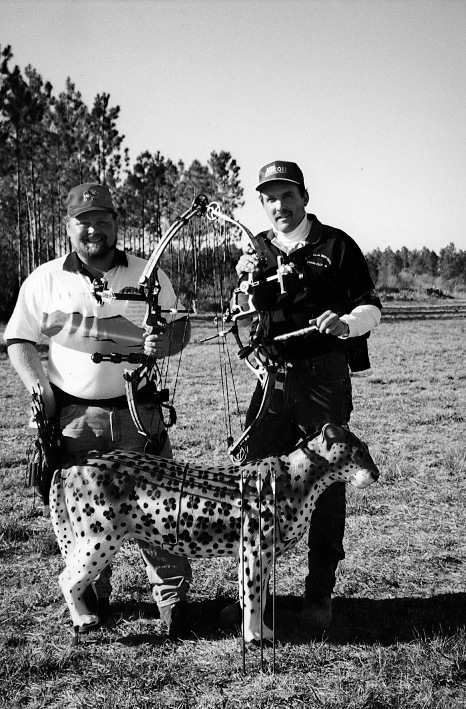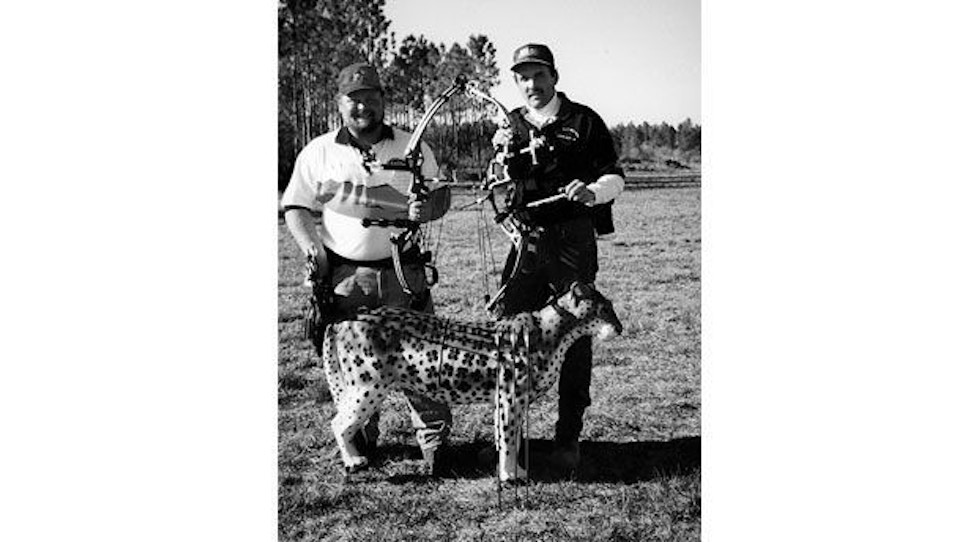Previously: Fence Rows And Farms
Practice Makes Perfect
 Greg lets young bucks, 2- to 3-year-olds, walk by and concentrates on the larger does and, of course, the heavy-racked older bucks. “Normally,” he explains, “I get one real good buck a year plus a couple of smaller ones in the 140 class.”
Greg lets young bucks, 2- to 3-year-olds, walk by and concentrates on the larger does and, of course, the heavy-racked older bucks. “Normally,” he explains, “I get one real good buck a year plus a couple of smaller ones in the 140 class.”
With many hunters, this would sound like bragging. Pyle, however, has the antlers to back up his claims and notions, and he exudes a genuine enthusiasm and confidence for his hunting that is both disarming and contagious.
“Since I’m after mature bucks and they are extremely sensitive to pressure and changes in their environment, I try to keep the areas I hunt as natural as possible,” he says. “I have access to a four-wheeler, but the noise of the engine radiates danger to deer that are already skittish. I drive into my hunting areas with lights out. I don’t slam doors.
“I try to keep a large area, maybe around 100 yards radius, as scent-free as possible. No artificial urines or estrus products. Also, people stink. That is one of the biggest problems hunters have, so a Scent-Lok suit and rubber boots are almost essential.
“Well, I do use urine that I collect from does that season, especially if she is hot!”
Pyle took his largest deer from a treestand in an Indiana fence row. “I usually hunt this particular area in November and December when, depending on the weather, deer are beginning to herd up,” he says. “That day, I saw 47 deer in all, including eight good bucks.
“I hung my stand 90 yards from an old, abandoned farm house and got a fleeting look at a deer I’d seen a couple of times, a big boy in the 180 to 190 class, maybe a 12-pointer with a 26-inch inside spread. I figured he was 7 or 8 years old.
“Old bucks like that can’t be patterned. They are independent. I think that if they live five years, they become pattern-free, routine-free.”
That November evening, Pyle saw a big buck stand up in a fence row crossing that he had pre-measured as 55 yards away. It was a deer he had seen earlier in the year and expected it would score high. Heavy beams. A nearly perfect 5x5 with the curve of the antlers well out beyond the ears.
For nearly 15 minutes, the buck stood grooming itself. Pyle figured he would get only one shot. Because he shoots a fast arrow with a flat trajectory; because he has checked and marked the distance from his stands to visible markers around him; because he shoots almost year-round and regularly practices shooting at 60 and even 80 yards (“I have learned to hold a five-inch group at 80 yards,” he says), he took the shot.
Pyle estimated the buck was 40 to 41 yards away, drew carefully, and sighted through his scope. As soon as he released, he knew he had the deer. The arrow took the buck quartering away and penetrated both lungs as well as smashing the front shoulder.
“I let him lay for an hour and a half and went to get some friends to help me drag him out,” he recalls.
“I’ve lost several deer to coyotes when I let them lay down a little too long after a shot. Maybe I got a little too complacent since I was hunting private land. But when I can, I give deer plenty of time to bleed, stiffen up, and die. I don’t follow them too fast.
“The longer you give a hit deer to find a spot and lie down, within reason, the more likely you are to recover it. I don’t believe in shooting and then jumping right up to chase them.
“Well, it turned out he only went 70 yards. Field dressed, he weighed 239 pounds.”
In all, Pyle has taken nearly 30 “big deer” from his southern Indiana, southern Illinois, and northern Kentucky hunting areas. He has mounted 10 of them, mostly those that scored 140 and above. The rest of the antlers he stores in boxes. “I have boxes and boxes of antlers,” he says with sheer enthusiasm.
Much of this passionate and loquacious hunter’s success can be categorized in five areas:
1. An ability to scout year-round.
2. Developing hunting strategies based on what he sees on the ground.
3. A true zest for the hunting way of life.
4. A studious approach to modern technology.
5. Shooting the national 3-D competition circuit, which keeps his distance-judging skills sharp.
Pyle attributes a good measure of his success to technology: a flat-shooting bow and a scent-free hunting suit. He also uses good binoculars and rangefinding abilities that come with shooting a scope, unusual for bowhunters.
“A scope eliminates any three-pin or four-pin confusion,” he notes. “Because I use a low-power lens in it, the light-gathering coatings allow me to see clearly 15 minutes earlier and later than most bowhunters on any given day. And the fiber optic pin is unmistakable against any background.”
Using a scope for a sight makes Pyle unusual among bowhunters, but that’s OK with him. He has the trophies and the antlers—boxes of them—to prove that his fence row system works.
Next: Bowhunting Fence Rows—The Bottom Line






